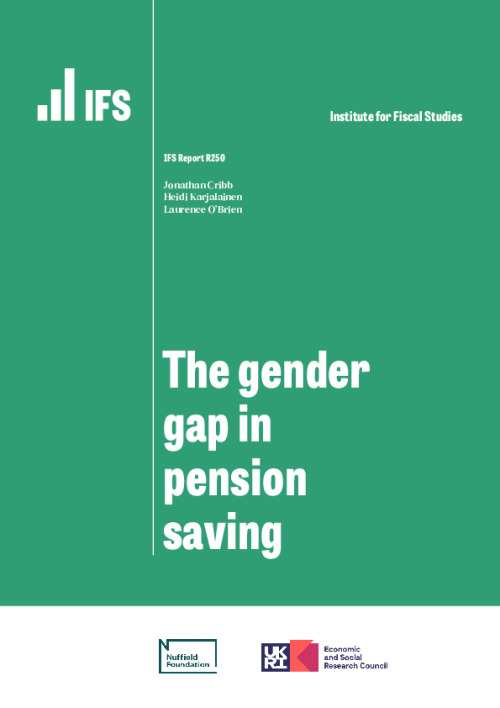In this report, we document differences in pension incomes and pension saving between men and women in the UK, and analyse the drivers behind these differences. In particular, we examine two different ‘gender pension gaps’. First is the gap in average private and state pension incomes between men and women who are already over state pension age. Second is the gap in average pension saving between working-age men and women, with a focus on how this is affected by differences in labour market experiences, and how the gaps differ for private sector employees, public sector employees and the self-employed.
Key findings
Gaps in incomes between men and women over state pension age
1. Men used to receive significantly more state pension income than women, but that gap has almost closed for people reaching state pension age in recent years. While women born in the early 1940s receive around 25% less in state pension income than men on average, this gap is below 5% for those born in the early 1950s.
2. However, the gap in private pension income between men and women over state pension age is wider and has narrowed considerably less. For example, women born in the late 1930s had average gross private pension income almost 60% lower than men during their early 70s; a similar gap existed between men and women born in the late 1940s. There has been a slight narrowing of the gap for those born in the early 1950s to around 45%, however.
Gaps in pension saving between working-age men and women
3. Focusing on 22- to 59-year-olds, we find that 59% of women were saving into a pension in 2019, compared with 66% of men. This gap in pension participation is mainly driven by the fact that women are less likely than men to be in paid work: 77% of both male and female workers are saving in a pension.
4. On average, across all working-age people, women had average total annual pension contributions of £2,600, compared with £3,400 for men. This difference in the amount entering men’s and women’s pension pots will be a direct determinant of differences in private pension incomes among future retirees. The most important driver is differences in average earnings: averaged across all people participating in a pension scheme, women actually contribute a higher proportion of their pay into their pension (15%) than men (13%).
5. The differences in sectoral composition between the male and female workforces work to increase women’s pension contributions compared with men’s. In 2019, 32% of female workers and only 17% of male workers worked in the public sector, where pension participation is high and average contribution rates much larger than in the private sector. In addition, only 10% of female workers are self-employed, compared with 15% of male workers, and less than one in five self-employed workers are saving into a pension.
Gaps in pension saving between male and female employees
6. Looking only at employees, men and women have fairly similar workplace pension participation rates, but this masks important differences between those working in the private sector and those working in the public sector. In the private sector, women have had persistently lower workplace pension participation than men, although automatic enrolment has led to the gap narrowing slightly in recent years from 7 percentage points in 2012 to 5 percentage points in 2020. In the public sector, the gap in workplace pension participation has now disappeared, having been 4 percentage points in 2012.
7. There are also differences in average pension contribution rates between men and women among those saving in a pension in the public and private sectors. In the public sector, there is a gap in average total contribution rates in favour of men which initially widens with age, reaching 2.5% of pay by age 40, but which narrows after age 50. Differences are much smaller in the private sector, with women having a slightly higher average total contribution rate up to their mid 40s, and men having a slightly higher rate thereafter.
8. Differences in pension participation rates and contribution rates (i.e. as a percentage of pay) between male and female employees are predominantly explained by differences in earnings between men and women which also widen with age. The £10,000 annual earnings threshold for automatic enrolment is particularly important in the private sector because more women work part-time and therefore earn less than this amount: there is essentially no gap in pension participation between male and female employees earning over £10,000 per year. In the public sector, differences in contribution rates can be explained by differences in earnings and industry, consistent with fairly rigid contribution structures by earnings in public sector schemes.
Gaps in pension saving between male and female self-employed workers
9. The gap in pension participation rates between male and female self-employed workers has fallen considerably over time, from a gap of 21 percentage points in 1998 to only 6 percentage points in 2020. This results from the stark decline in pension participation for self-employed men (especially in the early 2000s), which fell by 31 percentage points from 54% in 1998 to 22% in 2020, compared with a fall of 17 percentage points (33% to 16%) among self-employed women.
10. Gaps in private pension participation and contributions between male and female self-employed workers are smaller once differences in earnings are accounted for. But even after controlling for earnings, self-employed men are more likely to participate in a pension scheme than self-employed women. However, among those participating in a pension, self-employed women contribute as much as, or more than, self-employed men who have similar earnings.
Summary and policy implications
11. These findings show that there is no one single pension saving gender gap, as the size (or existence) of the gap depends on whether we consider all working-age individuals, or focus on different types of workers. Policies aimed at addressing the gender pension gap have to be clear on which gap is going to be targeted. Indeed, differences caused by labour market experiences may well be better addressed by policies designed to affect these labour market differences, rather than using pension saving policy. However, because private retirement incomes are increasingly reliant on defined contribution pensions which are decumulated through retirement, women – who have lower lifetime earnings on average and have longer retirements – are likely to continue to have lower retirement incomes than men.











